Can AI robots replace human astronauts in space?

 BBC
BBCOn Christmas Eve, an autonomous spacecraft passed by the Sun, closer than any man-made object before it. Roaming through the atmosphere, NASA’s Parker Solar Probe was on a mission to learn more about the Sun, including how it affects space weather on Earth.
It was a watershed moment for humanity – but no humans were directly involved, as the spacecraft carried out its pre-programmed tasks on its own as it passed by the Sun, whose orbit was near Earth. There was no communication with.
Robotic probes have been sent into the solar system for the past six decades, reaching places impossible for humans. During his 10-day flightParker Solar Probe experienced temperatures of 1000C.
But the success of these autonomous spacecraft – along with the rise of new advanced artificial intelligence – raises questions about what role humans might play in future space exploration.
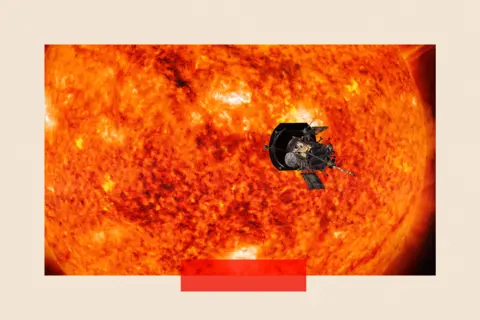 NASA
NASASome scientists question whether human astronauts will be needed at all.
“Robots are developing rapidly and the case for sending humans is becoming increasingly weak,” says British Astronomer Royal Lord Martin Rees. “I don’t think any taxpayer money should be used to send humans into space.”
He also points to the danger to humans.
He argues, “The only case for sending humans (there) is an adventure, an experience for rich people and should be privately funded.”
Physicist Andrew Coates of University College London agrees. “For serious space exploration, I prefer robotics,” he says. “(They) go much further and do more.”
 NASA
NASAThey argue that they are also cheaper than humans. “And as AI advances, robots can get smarter.”
But what does this mean for future generations of budding astronauts – and certainly there are some tasks that humans can do in space but that robots, no matter how advanced, never can?
Rovers verses to mankind
Robotic spacecraft have visited every planet in the solar system, as well as many asteroids and comets, but humans have visited only two destinations: Earth orbit and the Moon.
In total, about 700 people have gone into space since 1961, when Yuri Gagarin of the then Soviet Union became the first space explorer. Most of them have gone into orbit (circling the Earth) or sub-orbit (short vertical jumps lasting minutes in space) on vehicles such as US company Blue Origin’s New Shepard rocket.
“Reputation will always be a reason we have humans in space,” says Dr. Kelly Weinersmith, a biologist at Rice University, Texas, and co-author of A City on Mars. “There seems to be consensus that this is a great way to show that your political system is effective and your people are talented.”
But in addition to the innate desire to explore or a sense of prestige, humans also conduct research and experiments in Earth orbit, such as on the International Space Station, and use these to advance science.
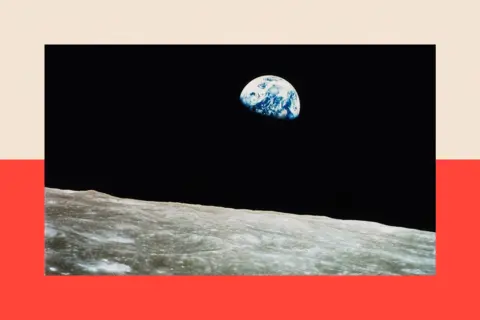 NASA
NASARobots can contribute to scientific research by having the ability to travel to locations inaccessible to humans, where they can use instruments to study and investigate atmospheres and surfaces.
“Humans are more versatile and we get things done faster than robots, but it’s really hard and expensive to survive in space,” says Dr. Weinersmith.
In her 2024 Booker Prize-winning novel Orbital, author Samantha Harvey puts it more lyrically: “A robot has no need of hydration, nutrients, excretion, sleep… He wants nothing and nothing Doesn’t even ask.”
But it also has negative aspects. Many robots are slow and methodical – for example on Mars, rovers (remote-controlled motor vehicles) move at barely 0.1 mph.
“AI can beat humans at chess, but does that mean they’ll be able to beat humans at environmental exploration?”. asks Dr. Ian Crawford, a planetary scientist at the University of London. “I don’t think we know.”
However, he believes AI algorithms could enable rovers to be “more efficient”.
AI assistants and humanoid robots
Technology can play a role in complementing human space travel by freeing astronauts from certain tasks and allowing them to focus on more important research.
“AI can be used to automate difficult tasks,” explains Dr Kiri Wagstaff, a computer and planetary scientist in the US who previously worked at NASA’s Jet Propulsion Laboratory in California. “On the surface of a planet, humans get tired and lose focus, but machines won’t do that.”
The challenge is that large amounts of power are required to operate systems such as large language models (LLM), which can understand and generate human language by processing large amounts of text data. “We are not at the point of being able to run LLM on a Mars rover,” says Dr. Wagstaffe.
“The rovers’ processors run at about one-tenth the speed of your smartphone” – meaning they are unable to cope with the intense demands of running an LLM.
Complex humanoid machines with robotic arms and limbs are another form of technology that can perform basic tasks and functions in space, especially as they more closely mimic the physical capabilities of humans.
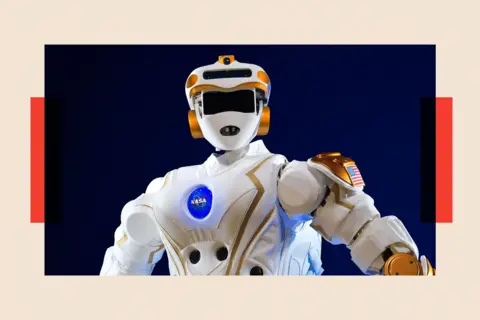 NASA
NASANASA’s Valkyrie robot was built by the Johnson Space Center to compete in the 2013 Robotics Challenge test. Weighing 300 pounds and standing 6 feet 2 inches tall, it looks not unlike a Star Wars Stormtrooper, but it is one of a growing number of human-like machines with superhuman abilities.
Long before the construction of Valkyrie, NASA’s robonaut It was the first humanoid robot designed for use in space, performing tasks that would otherwise be performed by humans.
Its specially designed hands mean it can use the same tools as astronauts and carry out complex, delicate tasks like grasping objects or flicking switches, which are very difficult for other robotic systems. Were challenging.
A later model of Robonaut was flown to the International Space Station aboard the Space Shuttle Discovery in 2011, where it helped with maintenance and assembly.
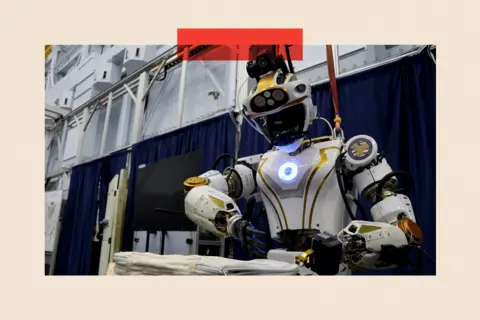 reuters
reuters“If we need to replace a component or clean a solar panel, we can do that robotically,” says Dr. Shawn Azimi, head of the intelligent robotics team at NASA’s Johnson Space Center in Texas. “We see robots as a way to secure these habitats when humans are not around.”
He argues that robots may be useful not to replace human investigators but to work alongside them.
Some robots are already working on other planets without humans, sometimes even making decisions on their own. For example, NASA’s Curiosity rover is to explore An area on Mars called Gale Crater performs some of its science autonomously without human input.
Dr. Wagstaffe says, “You can direct the rover to take pictures of a scene, look for rocks that might fit into the science priorities for the mission, and then autonomously point your laser at Can fire at that target.”
“It can get readings of a particular rock and send it back to Earth while humans are still sleeping.”
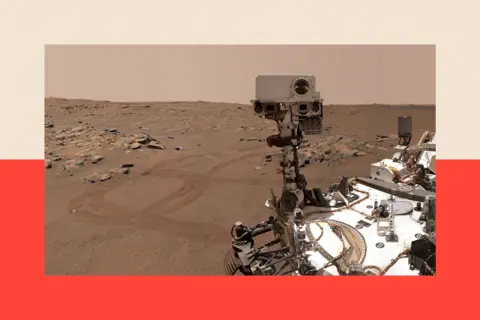 NASA
NASABut the capabilities of rovers like Curiosity are limited because of their slow speed. And there’s something else they can’t compete with. That is, humans have the added advantage of motivating people back on Earth in a way that machines cannot.
Professor Coates argues, “Motivation is something that is intangible.”
Leroy Chiao, a retired NASA astronaut who flew three space flights aboard NASA’s space shuttle and the International Space Station in the 1990s and 2000s, agrees. “Humans relate when they are doing something.
“The general public is excited about robotic missions. But I hope the first humans to Mars will be even bigger than the first landing on the Moon.”
Life on Mars?
Since December 1972, when the last Apollo mission visited the Moon, humans have not traveled beyond Earth’s orbit. NASA is hoping to return humans there this decade with its Artemis program.
Next Crew Mission 2026 will see four astronauts flying around the Moon. Another mission scheduled for 2027 will land NASA astronauts on the lunar surface.
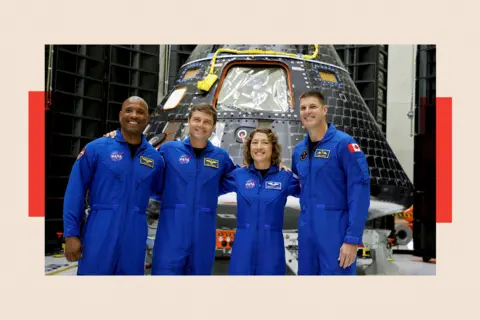 reuters
reutersMeanwhile, the Chinese space agency also wants to send astronauts to the Moon.
On the other hand, Elon Musk, CEO of American company SpaceX, also has his own plans related to space. He has said that his long-term plan is to build a colony on Mars, where humans can live. land,
His idea is to use the Starship, a giant new vehicle that his company is developing, with the aim of carrying up to 100 people there at a time. One million people on Mars in 20 years,
“Musk is arguing that we need to go to Mars because it can be a backup for humanity if something catastrophic happens on Earth,” explains Dr. Weinersmith. “If you accept that logic, then sending humans into space is necessary.”
However, there are big unknowns about living on Mars, including myriad technical challenges that he says are still unresolved.
“Children may not be able to thrive in that environment,” she says. “There are[such]ethical questions that we don’t have answers to.”
“I think we should slow down.”
However, Lord Rees has a vision of his own, in which human and robotic exploration could merge to such an extent that humans themselves are part of a machine to deal with extreme environments. “I can imagine that they would use all kinds of technologies, including genetic modification, cyborg add-ons, and so on, to deal with very hostile environments,” he says.
“We may have a new species that will be happy living on Mars.”
However, until then, humans are likely to continue their baby steps into the universe, following a path long trodden by robotic explorers before them.
Top image credit: NASA
bbc indepth The best analysis and expertise from our top journalists has a new home on the website and app. Under a distinctive new brand, we’ll bring you fresh perspectives that challenge assumptions, and in-depth reporting on the biggest issues to help you understand a complex world. And we’ll also feature thought-provoking content from BBC Sounds and iPlayer. We’re starting small but thinking big, and we want to know what you think – you can send us your feedback by clicking the button below.






